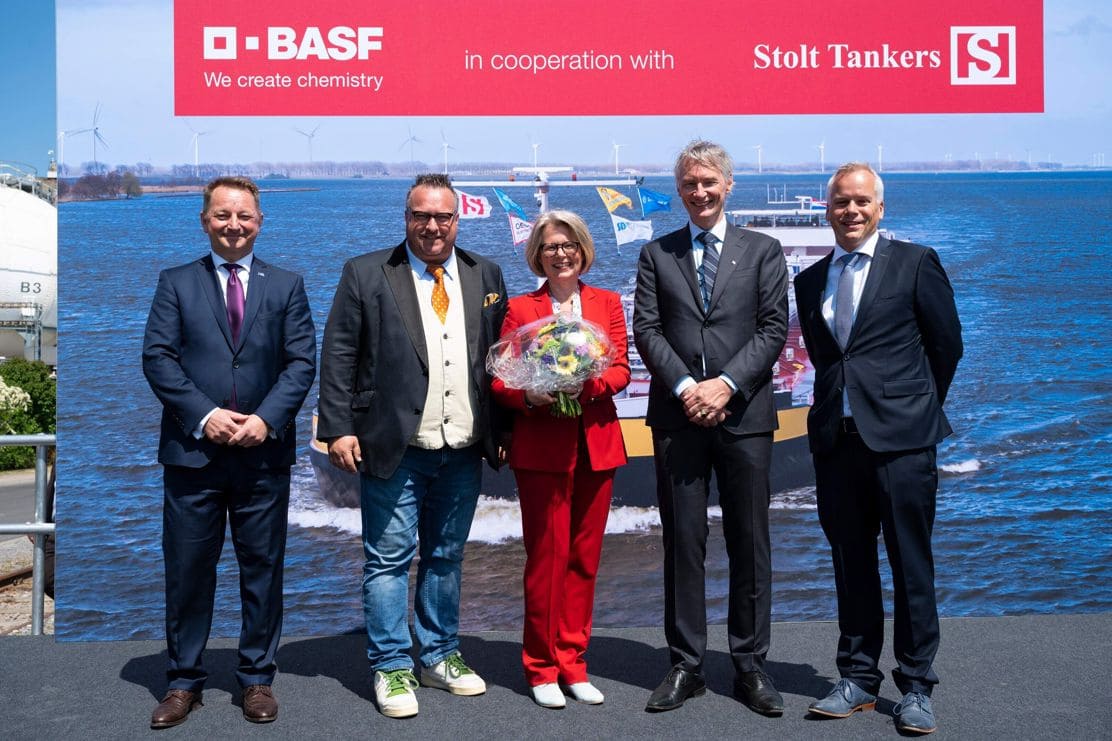The innovative ship is the result of a successful partnership between BASF, Stolt Tankers, Mercurius Shipping Group, and a consortium consisting of Duisburger Entwicklungszentrum für Schiffstechnik und Transportsysteme, Technolog Services GmbH, and Agnos Consulting.
Lucas Vos, President of Stolt Tankers, said: “This exciting project demonstrates Stolt Tankers’ commitment to developing new technologies and ship designs for a sustainable maritime industry. I am proud of the team involved in bringing the vision for a tanker that can operate at the lowest water levels on the Rhine to life. We are looking forward to operating the Stolt Ludwigshafen exclusively for BASF and contributing to the security of its supply chain in the region.”
Uwe Liebelt, President, European Verbund Sites, BASF SE, added: “Following the extreme low water levels on the Rhine in 2018, we initiated an extensive programme to improve climate resilience at the Ludwigshafen site. With today’s christening of the Stolt Ludwigshafen, we are concluding the implementation of this diverse package. Now BASF takes advantage of the most powerful low-water vessel on the Rhine, ensuring the supply to our customers and production plants.
“The fact that we can inaugurate this brand-new vessel together with our partner Stolt Tankers is a proud moment for all of us. Today, we celebrate the fruitful partnership of both our companies and the innovation power of the consortium of barge experts which we founded four years ago. For me, this vessel is an excellent example for securing Europe as competitive industry location by technology lead.”
“This exciting project demonstrates Stolt Tankers’ commitment to developing new technologies and ship designs for a sustainable maritime industry.“ – Lucas Vos, President of Stolt Tankers
Prior to its christening, guests were given the opportunity to take a tour of the ship. Accompanied by his crew, Captain Horst Schweiger escorted the guests around the Stolt Ludwigshafen from the deck to the wheelhouse and the engine room, highlighting its many innovative features.
Stolt Ludwigshafen at a glance
The tanker was built between mid-2021 and 2023. The hull was manufactured by Mercurius Shipping Group in Yangzhou, China, on behalf of Stolt Tankers. It was then transported to Rotterdam, Netherlands, to complete the outfitting of the ship.
After successful test trials, the Stolt Ludwigshafen completed its first trip for BASF at the end of April 2023 (pictured).
This innovative inland tanker has a unique design: to achieve a high load-bearing capacity, the dimensions of the new ship are 135 by 17.5 metres, which is considerably larger than conventional tankers on the Rhine. To further optimise the cargo capacity, the hull features a special lightweight construction while ensuring high structural stability. Additionally, the ship has a hydrodynamically optimised hull, and a special propulsion system adapted to allow safe operation even under extreme low-water conditions.
These features allow the ship to pass the critical point in the river Rhine near Kaub with a cargo payload of 800 tonnes even at a gauge level of 30 centimetres (corresponding to a water depth of 1.6 metres). At moderately low water levels (e.g., Kaub gauge of 100 centimetres), its loading capacity of around 2,300 tonnes will be twice that of conventional inland vessels. Overall, the Stolt Ludwigshafen will feature a maximum loading capacity of 5,100 tonnes.
The ship is powered by three electric motors, which are fed by the latest generation of highly efficient Stage‑V diesel generators with exhaust gas after-treatment. These engines enable high efficiency and provide an optimised environmental footprint, leading to a reduction of carbon dioxide emissions of around 30 percent and nitrogen oxide emissions of around 70 to 80 percent.
In the future, existing diesel generators will have the potential to be modified to allow the use of methanol as a fuel source or will be able to be replaced by other generator types (e.g., hydrogen fuel cells) once these technologies achieve market maturity.
Contact:
Stolt Tankers
Tel: +44 207 611 8960

